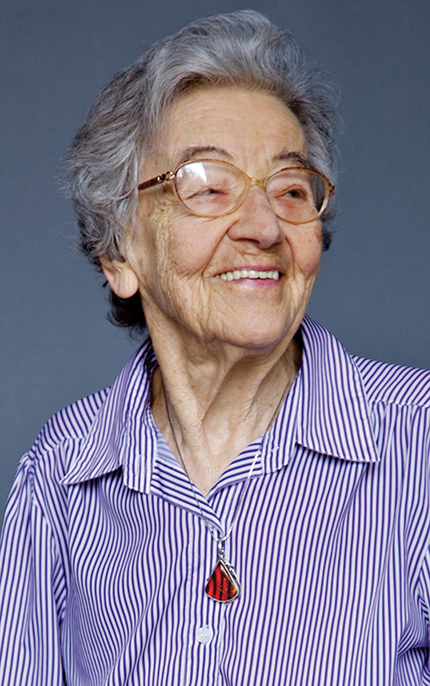Ursula Martius Franklin
DOI: 10.1063/PT.3.3634
Ursula Martius Franklin died peacefully in Toronto on 22 July 2016. With her passing, Canada lost a consummate scientist who was praised for her commitment to education, particularly for young women in science and engineering; to feminism; and to social justice.

Ursula Martius Franklin
UNIVERSITY OF TORONTO/MARK NEIL BALSON

Born in Munich on 16 September 1921, Ursula was the only child of Albrecht Martius, an archaeologist, and Ilse Maria Martius, an art historian. A close family friend, physicist Hans Kuppenheim, was instrumental in guiding Ursula to a life of science. In 1940 she began studying chemistry and physics at the University of Berlin, but because of her Jewish heritage, she was removed from the university. Interned in a labor camp near the end of World War II, she was forced to work outside repairing bombed buildings in conditions that caused permanent frostbite damage to her limbs.
Following the armistice, Ursula forged ahead and completed her undergraduate studies at the Technical University of Berlin in 1946 and then a PhD degree in experimental physics under the supervision of Richard Becker at the same institution in 1948. Ursula’s deep-rooted interest in history, literature, and law, coupled with her appetite to understand the workings of the physical world, would shape her as a trailblazer in archaeometry, pacifism, and education.
Ursula’s desire to stay in the country was tempered by the winds blowing in postwar Germany, where, according to Ursula, “The only things that could not be censored [by the state] were mathematics and physics.” So in 1949 she accepted a Lady Davis Fellowship for postdoctoral studies in physics and metallurgy at the University of Toronto, which came with the promise of permanent residency.
From 1952 to 1967, Ursula was a senior scientist at the Ontario Research Foundation. She studied metals and alloys and contributed to numerous important advances of the time, including the world’s first porous-coated skeletal hip-implant design.
While at the foundation, Ursula accomplished what is considered to be her most far-reaching research. As a Quaker and a devout pacifist, she was moved to investigate whether radioactive isotopes produced by atmospheric weapons tests were being absorbed by humans in detectable quantities. Working with the peace group Voice of Women, Ursula approached family, friends, and colleagues to collect numerous baby teeth. She and her coworkers detected large quantities of strontium-90, which has been shown to significantly increase the risk of blood and bone cancers. Their findings contradicted the theory that radioactive fallout from weapons tests remained in the upper atmosphere. That work led to the 1963 Partial Nuclear Test Ban Treaty—signed by 135 countries—which outlawed nuclear detonations on land, in the atmosphere, and in space.
In 1967 Ursula returned to the University of Toronto, which had recently created the Centre for Materials Research. She became the first woman professor in the department of metallurgy and materials science and only the second female professor in the Faculty of Applied Science and Engineering.
Ursula’s other significant achievement was her development of the field of archaeometry, in which modern materials science techniques are used to analyze archaeological artifacts. The field combined her expertise in physics, materials science, and metallurgy and her understanding of how materials have been used throughout history. In the hundreds of publications she wrote on archaeological science, Ursula demonstrated that the ways in which earlier civilizations used tools helped shape their culture, heritage, and organization.
Long before sustainability, life-cycle design, green manufacturing, and other climate-related issues became common subjects in engineering curricula, Ursula often talked about how we need to safely return to Earth all that we “borrow.” In her classes, she always demonstrated a profound awareness of the impact of scientific research beyond the lab, both on society and the environment.
After she retired from the Faculty of Applied Science and Engineering in 1989, Ursula started a second career as a senior fellow at the University of Toronto’s interdisciplinary Massey College. It was a good fit for her and her integrative approach to science. She worked there for most of her last 25 years mentoring many graduate students in virtually all disciplines to think beyond the conventional. Ursula’s prolific years at the college are reflected in her incisive and predictive lectures and publications on the impact and dangers of technology on future societies.
In 1995 Ursula was honored by having a new Toronto public school named after her. Like its namesake, it embraces community service; as principal Georgia Gallagher said in a statement, it was conceived “with [Ursula’s] vision for social justice, democracy, a spirit of inquiry, and connected knowledge to create a community of learners.”
Ursula received numerous awards and medals, including the Governor General’s Award in Commemoration of the Persons Case in 1991 for her work on behalf of gender equality in Canada and the Pearson Medal of Peace in 2001. She was inducted into the Canadian Science and Engineering Hall of Fame in 2012.
Ursula Franklin was a transformational innovator in science and education, a social activist, and a fierce advocate for women and for peace. She will be greatly missed.
More about the Authors
Doug D. Perovic. University of Toronto, Toronto, Ontario, Canada.
